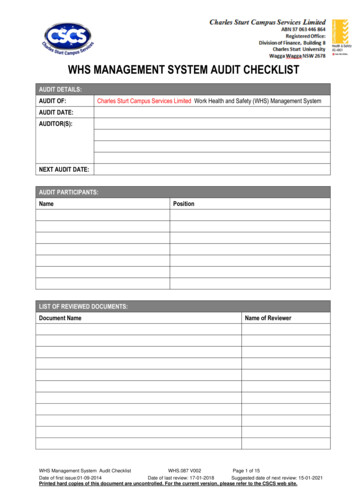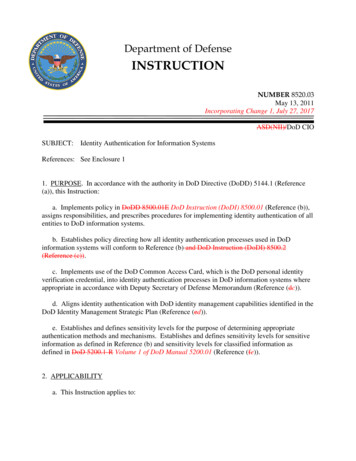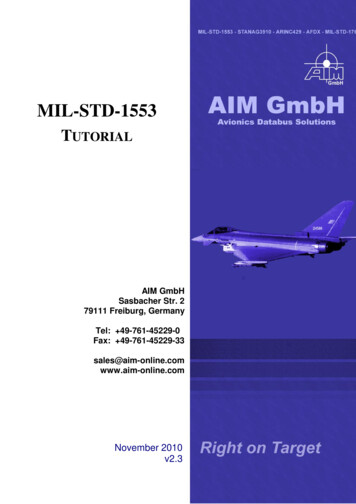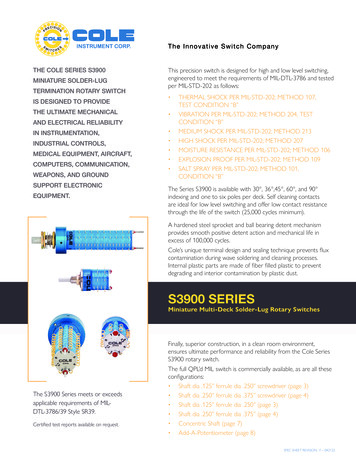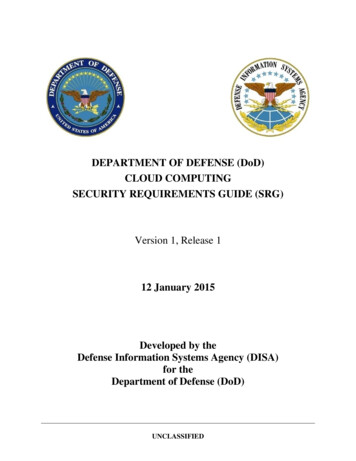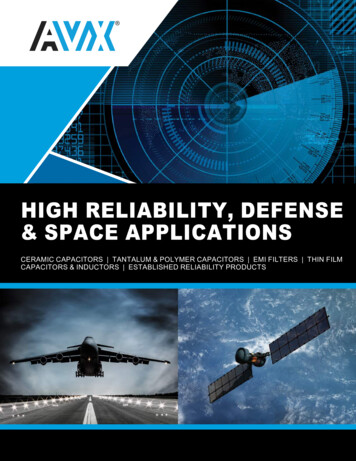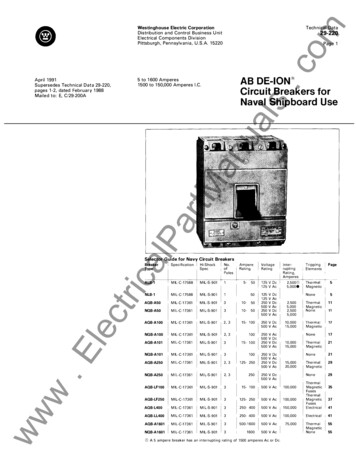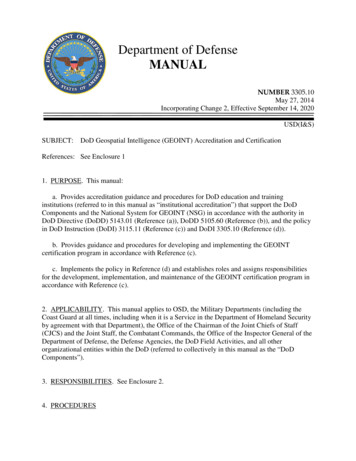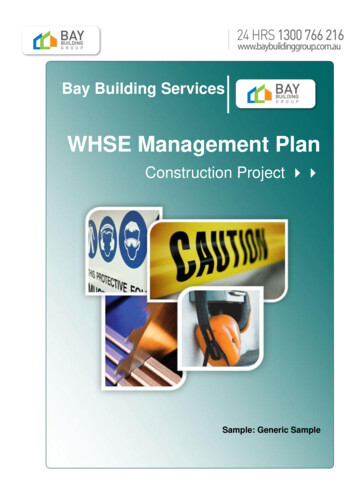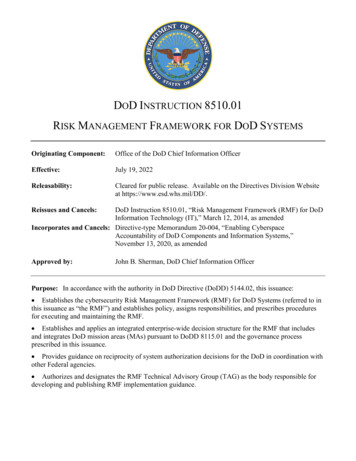
Transcription
DOD INSTRUCTION 8510.01RISK MANAGEMENT FRAMEWORK FOR DOD SYSTEMSOriginating Component:Office of the DoD Chief Information OfficerEffective:July 19, 2022Releasability:Cleared for public release. Available on the Directives Division Websiteat https://www.esd.whs.mil/DD/.Reissues and Cancels:DoD Instruction 8510.01, “Risk Management Framework (RMF) for DoDInformation Technology (IT),” March 12, 2014, as amendedIncorporates and Cancels: Directive-type Memorandum 20-004, “Enabling CyberspaceAccountability of DoD Components and Information Systems,”November 13, 2020, as amendedApproved by:John B. Sherman, DoD Chief Information OfficerPurpose: In accordance with the authority in DoD Directive (DoDD) 5144.02, this issuance: Establishes the cybersecurity Risk Management Framework (RMF) for DoD Systems (referred to inthis issuance as “the RMF”) and establishes policy, assigns responsibilities, and prescribes proceduresfor executing and maintaining the RMF. Establishes and applies an integrated enterprise-wide decision structure for the RMF that includesand integrates DoD mission areas (MAs) pursuant to DoDD 8115.01 and the governance processprescribed in this issuance. Provides guidance on reciprocity of system authorization decisions for the DoD in coordination withother Federal agencies. Authorizes and designates the RMF Technical Advisory Group (TAG) as the body responsible fordeveloping and publishing RMF implementation guidance.
DoDI 8510.01, July 19, 2022TABLE OF CONTENTSSECTION 1: GENERAL ISSUANCE INFORMATION . 41.1. Applicability. . 41.2. Policy. . 4SECTION 2: RESPONSIBILITIES . 62.1. DoD CISO. . 62.2. Director, Defense Information Systems Agency (DISA). . 62.3. Under Secretary of Defense for Acquisition and Sustainment. . 72.4. USD(R&E). . 72.5. DOT&E. . 82.6. Director, National Security Agency/Chief, Central Security Service. 82.7. OSD and DoD Component Heads. . 82.8. Chairman of the Joint Chiefs of Staff. . 102.9. Commander, United States Strategic Command. . 112.10. Commander, United States Space Command. . 112.11. Commander, USCYBERCOM. . 11SECTION 3: DOD AND NIST RMF IMPLEMENTATION. 123.1. Overview. . 123.2. RMF Steps. . 13a. Prepare. 13b. Categorize . 15c. Select. . 15d. Implement. . 16e. Assess. . 17f. Authorize. . 18g. Monitor. . 193.3. Integrating The RMF into the Defense Acquisition Management System. . 20a. Overview. . 20b. Life-Cycle. . 20SECTION 4: CYBERSECURITY RISK GOVERNANCE . 214.1. Cybersecurity Risk Governance. . 214.2. Level 1 – Organization. 22a. DoD CISO. . 22b. Risk Executive Function. . 23c. DoD Cybersecurity Architecture. 23d. RMF TAG. . 24e. RMF KS. . 244.3. Level 2 – Mission or Business Processes. . 24a. JCA CPM. . 25b. PAO. 25c. DoD Component CIO. . 25d. DoD Component CISO. . 264.4. Level 3 – Systems. . 27TABLE OF CONTENTS2
DoDI 8510.01, July 19, 2022a. AOs. . 27b. System Cybersecurity Program. 284.5. RMF Role Appointment. . 30SECTION 5: RMF KS . 315.1. Overview. . 315.2. RMF KS. . 31GLOSSARY . 32G.1. Acronyms. . 32G.2. Definitions. 33REFERENCES . 35TABLESTable 1.Table 2.Table 3.Table 4.Table 5.Table 6.Table 7.Table 8.Organization Prepare Step Tasks . 13Categorize Tasks and Outcomes . 15Select Tasks and Outcomes . 15Implement Tasks and Outcomes . 16Assessment Tasks and Outcomes . 17Authorization Tasks and Outcomes . 18Monitor Tasks and Outcomes . 19Appointment of RMF Roles . 30FIGURESFigure 1. RMF Process . 12Figure 2. Cybersecurity Risk Governance . 22TABLE OF CONTENTS3
DoDI 8510.01, July 19, 2022SECTION 1: GENERAL ISSUANCE INFORMATION1.1. APPLICABILITY.This issuance applies to OSD, the Military Departments (including the Coast Guard at all times,including when it is a Service in the Department of Homeland Security by agreement with thatDepartment), the Office of the Chairman of the Joint Chiefs of Staff and the Joint Staff, theCombatant Commands, the Office of Inspector General of the Department of Defense, theDefense Agencies, the DoD Field Activities, and all other organizational entities within the DoD(referred to collectively in this issuance as the “DoD Components”).1.2. POLICY.a. The RMF process will inform acquisition processes for all DoD systems, includingrequirements development, procurement, developmental test and evaluation (DT&E), operationaltest and evaluation (OT&E), and sustainment; but will not replace these processes.b. In accordance with Executive Order 13800, the National Institute of Standards andTechnology (NIST) publications will be the authoritative guidelines for the DoD RMF.c. DoD RMF must meet the requirements of Subchapter II of Chapter 35 of Title 44, UnitedStates Code, also known as and referred to in this issuance as the “Federal Information SecurityModernization Act of 2014” (FISMA) and Section 11331 of Title 40, United States Code.d. Cybersecurity requirements and cyberspace operational risk management functions willbe established and applied to all programs, systems, and technologies in DoD, regardless of theacquisition or procurement method (referred to collectively in this issuance as “systems”).e. Accountability for cybersecurity risk accepted within DoD must be enforced at all levelswithin the OSD or DoD Component in question (e.g., executive program officers, programmanagers (PMs), authorizing officials (AOs), and cyberspace and functional operationalcommanders) and throughout the lifecycle of its systems in accordance with DoDD 3020.04,DoD Instructions (DoDIs) 8500.01, 8010.01, and 3020.45, and this issuance.f. The DoD Information Enterprise will use cybersecurity reciprocity to reduce redundanttesting, assessing, documenting, and the associated costs in time and resources.g. The RMF system authorization information will be shared to support system to systemconnections across authorization boundaries and decisions for shared services within DoD, andin coordination with other Federal agencies, as appropriate.h. The DoD Chief Information Security Officer (CISO) will charter the RMF TAG tointerface with DoD Components on emerging RMF issues affecting the DoD InformationNetwork.SECTION 1: GENERAL ISSUANCE INFORMATION4
DoDI 8510.01, July 19, 2022i. The RMF Knowledge Service (KS) (found at https://rmfks.osd.mil) will be theauthoritative source for RMF implementation guidance, standards, and tools, as governed by theRMF TAG.j. DoD personnel making decisions affecting cybersecurity or cyber operational risk will beaccountable, as appropriate, for those decisions.SECTION 1: GENERAL ISSUANCE INFORMATION5
DoDI 8510.01, July 19, 2022SECTION 2: RESPONSIBILITIES2.1. DOD CISO.Under the authority, direction, and control of the DoD Chief Information Officer (CIO), the DoDCISO:a. Develops, implements, and oversees the Cybersecurity Program for DoD.b. Oversees implementation of this issuance and the cybersecurity risk management of DoDsystems, distributes RMF standards, and supports Joint Capabilities Area (JCA) owners indeveloping the required RMF guidance for their respective portfolios.c. Establishes the construct and program for AOs, including qualification and trainingrequirements, and ensures acquisition programs and DoD systems have AOs appointedconsistent with that construct. The construct must ensure the AOs, with the assistance of PMs orsystem owners (SOs), will:(1) Oversee cybersecurity activities, findings, and remediation actions fromdevelopmental, operational, and cybersecurity testing or assessment activities throughout thesystem lifecycle.(2) Ensure data from those activities are captured in security authorization packages toinform risk-based authorization decisions.d. Coordinates with the Under Secretary of Defense for Research and Engineering(USD(R&E)) and the Director, Operational Test and Evaluation (DOT&E) to ensurecybersecurity DT&E and OT&E policies, procedures, and guidance integrate with the RMFpolicies and procedures. Additional testing, such as user or functionality testing, is inaccordance with DoDI 5000.89.e. Assists other organizations in executing the RMF by providing subject matter expertise incoordination with the Chairman of the Joint Chiefs of Staff.f. Incorporates United States Cyber Command (USCYBERCOM) and National SecurityAgency/Central Security Service cyber operational risk tolerances into security authorizationbaselines, as applicable.2.2. DIRECTOR, DEFENSE INFORMATION SYSTEMS AGENCY (DISA).Under the authority, direction, and control of the DoD CIO, and in addition to the responsibilitiesin Paragraph 2.7., the Director, DISA:a. Oversees DISA control correlation identifiers, security requirements guides, and securitytechnical implementation guides to maintain consistency with the Committee on NationalSECTION 2: RESPONSIBILITIES6
DoDI 8510.01, July 19, 2022Security Systems Instruction (CNSSI) 1253; NIST Special Publication (SP) 800-53 security andprivacy controls; and NIST SP 800-53A assessment procedures.b. Develops and provides:(1) RMF training and awareness products.(2) A distributed training capability to support the DoD Components in accordance withDoDD 8140.01.(3) Training materials posted on the DoD Cyber Exchange at https://cyber.mil.c. Identifies or develops and distributes DoD enterprise RMF management tools.2.3. UNDER SECRETARY OF DEFENSE FOR ACQUISITION AND SUSTAINMENT.In addition to the responsibilities in Paragraph 2.7., the Under Secretary of Defense forAcquisition and Sustainment:a. Coordinates with the DoD CISO to integrate RMF policies, processes, and procedureswith Defense Acquisition System processes for acquisitions of DoD systems.b. Verifies DoD Component acquisition program executive offices and PMs are accountablefor coordinating tradeoff decisions during sustainment of systems (i.e., decisions to withhold ordelay vulnerability remediation, which significantly impact survivability of systems underconditions of the intended operational environment) with the requirements sponsors, AO, andComponent cyberspace operations forces.2.4. USD(R&E).In addition to the responsibilities in Paragraph 2.7., the USD(R&E):a. Coordinates with the DoD CISO and Director, National Security Service/Chief, CentralSecurity Service for consistent integration between:(1) The RMF policies and procedures.(2) Systems Engineering.(3) Developmental test, evaluation, and assessment policies and procedures.(4) Guidance for acquisition of DoD digital capabilities, including national securitysystems in coordination with the Director, National Security Service/Chief, Central SecurityService.b. Provides the RMF TAG with input as appropriate or required.SECTION 2: RESPONSIBILITIES7
DoDI 8510.01, July 19, 20222.5. DOT&E.In addition to the responsibilities in Paragraph 2.7., the DOT&E:a. Reviews the plans, execution, and results of operational testing to adequately evaluatecybersecurity for all DoD information technology acquisitions subject to oversight.b. In coordination with the DoD CISO, ensures OT&E findings are integrated into the RMFand provides the RMF TAG with input as appropriate or required.2.6. DIRECTOR, NATIONAL SECURITY AGENCY/CHIEF, CENTRAL SECURITYSERVICE.Under the authority, direction, and control of the Under Secretary of Defense for Intelligence andSecurity and the DoD CIO, as applicable in accordance with Section 142(b)(1)(D) of Title 10,United States Code, in addition to the responsibilities in Paragraph 2.7., and in coordination withthe DoD CISO, the Director, National Security Agency/Chief, Central Security Service:a. Recommends solutions to mitigate vulnerabilities in current operational weapons andspace systems.b. Recommends solutions to harden the security design of future systems.c. Assesses the overall security posture of National Security Systems, identifies theirvulnerabilities, and disseminates information regarding threats to DoD.d. In coordination with the cognizant AO, assesses cybersecurity requirements andinformation system security architectures of applicable National Security Systems beforeprogram initiation for new systems and all acquisition milestones.e. Provides verified system security engineering services to support the RMF when providedto DoD Components.f. Delivers threat and risk reports to support authorization decisions.2.7. OSD AND DOD COMPONENT HEADS.OSD and DoD Component heads:a. Integrate Component cybersecurity throughout system engineering and testing processesthat contribute to cyber resilience, survivability, materiel readiness, and cyberspace operationalreadiness.b. Manage Component cybersecurity risks to respective systems in accordance with theprinciples and processes contained in this issuance.SECTION 2: RESPONSIBILITIES8
DoDI 8510.01, July 19, 2022c. Establish and maintain cybersecurity governance bodies and methods to monitor andmanage system cybersecurity risks and integrate their Component governance processes with theDoD enterprise governance processes in this issuance.d. Develop and maintain Component level guidance required by the “Prepare” step of theRMF and verify that all subcomponents build and maintain the necessary guidance for theirbusiness or mission function.e. Categorize systems and select controls in accordance with CNSSI 1253 and implement acorresponding set of security controls in accordance with NIST SP 800-53.f. Require use of the DoD-specific assignment values, overlays, implementation guidance,and assessment procedures found on the RMF KS.g. Identify and allocate resources for the RMF in the DoD Planning, Programming,Budgeting, and Execution process.h. Implement continuous monitoring activities in accordance with Office of Managementand Budget Memorandum M-14-03, NIST SP 800-137, NIST SP 800-137A, and DoDIs 8530.01and 8531.01.i. Develop and maintain a plan of action and milestones (POA&M) to address knownvulnerabilities in the system, subsystems, and system components in accordance with DoDI8531.01.j. Adhere to a Component cybersecurity program in accordance with DoDI 8500.01.k. Conduct RMF activities in all phases of the DoD acquisition process (i.e., requirementsdevelopment, procurement, DT&E, OT&E, and sustainment) to increase security and decreasecost.l. Verify the appointment of a PM or SO for all Component systems.m. Appoint an AO for every system operating within or on behalf of the Component inaccordance with DoDI 8500.01 and Appendix D, Paragraph D.6 of NIST SP 800-39 andauthorize systems in accordance with this issuance. The AOs must:(1) Only be government personnel. This role cannot be re-delegated to personnel whodo not meet this requirement.(2) Possess relevant expertise with the leveraged technology as part of the system, andthis must be a factor in their selection and appointment as an official responsible for authorizingsystems.(3) Manage and reduce cybersecurity risk and complete duties, which are evaluated inannual performance evaluation criteria.(4) Complete AO training or an RMF training course offered by NIST.SECTION 2: RESPONSIBILITIES9
DoDI 8510.01, July 19, 2022n. Develop and issue systems guidance that reflects Component-unique operational andenvironmental demands as needed.o. Verify that Component processes regarding the RMF, cybersecurity, systems engineering,and testing are integrated and actively share system-related data across these processes ascontributors to cyber resilience, survivability, materiel readiness, and cyberspace operationalreadiness.p. Direct PMs and information SOs to maintain DoD systems under their authority tocomply with the RMF.q. Operate only authorized DoD systems with a current authorization to operate (ATO), andmaintain authorized DoD systems are maintained under their authority to comply with RMF.r. Manage, maintain, and mitigate risks throughout the system lifecycle in accordance withcybersecurity operational requirements.s. Oversee and verify that personnel engaged in, or supporting, the RMF are appropriatelytrained and possess professional certifications in accordance with DoDD 8140.01 and supportingissuances.t. Ensure Component information SOs appoint user representatives (URs) for DoD systemsunder their purview.u. Coordinate Component’s participation in the RMF TAG.v. Require that contracts and other agreements include specific requirements in accordancewith this issuance.w. Provide cybersecurity developmental, operational, and sustainment test and evaluation(T&E), and assessment results for acquisition and fielded programs to the appropriate AO toinform ATO decisions.x. Ensure acquisition programs submit cybersecurity T&E results to the appropriate AO toinform ATO decisions.y. Ensure acquisition programs develop evaluation metrics for DT&E and OT&E, andcontinuous monitoring, at the beginning of the development process.2.8. CHAIRMAN OF THE JOINT CHIEFS OF STAFF.In coordination with the DoD CISO, and in addition to the responsibilities in Paragraph 2.7., theChairman of the Joint Chiefs of Staff:a. Requires the Joint Capabilities Integration and Development System process to supportand document system categorization in accordance with this issuance.b. Maps systems to dependent missions.SECTION 2: RESPONSIBILITIES10
DoDI 8510.01, July 19, 2022c. Supports JCA owners in developing required RMF guidance for their portfolios.2.9. COMMANDER, UNITED STATES STRATEGIC COMMAND.In addition to the responsibilities in Paragraph 2.7., the Commander, United States StrategicCommand:a. Serves as the AO for nuclear command, control, and communication systems as identifiedby the Joint Staff (as the Warfighting MA Principal AO (PAO)).b. Delegates system-level responsibilities, as required.2.10. COMMANDER, UNITED STATES SPACE COMMAND.In addition to the responsibilities in Paragraph 2.7., the Commander, United States SpaceCommand:a. Assigns AOs for space systems.b. Issues authorization guidance in accordance with this issuance for space systems.c. Resolves authorization issues for space systems used by the DoD in accordance withDoDI 8500.01 and Committee on National Security Systems Policy No. 12.2.11. COMMANDER, USCYBERCOM.In coordination with the DoD CISO and in addition to the responsibilities in Paragraph 2.7., theCommander, USCYBERCOM:a. Coordinates with the other DoD Component heads to:(1) Ensure all cybersecurity risk management decision-makers are aware of significantcybersecurity risks.(2) Integrate the vulnerability management process into the RMF process.b. Coordinates with the Director, National Security Agency/Chief, Central Security Serviceto make cyberspace operations forces’ operational risk tolerances and relevant cyber threatinformation available to all cybersecurity risk management decision-makers to eliminate isolatedprocesses.SECTION 2: RESPONSIBILITIES11
DoDI 8510.01, July 19, 2022SECTION 3: DOD AND NIST RMF IMPLEMENTATION3.1. OVERVIEW.The RMF process for lifecycle cybersecurity risk to DoD systems is in accordance with the NISTSP 800-30, 800-37, 800-39, 800-53A, 800-137, Committee on National Security Systems PolicyNo. 22, CNSSI No. 1253 and 1254, DoDD 8000.01, and DoDI 8500.01. The RMF processadopts the NIST RMF in accordance with NIST SP 800-37 to comply with FISMA requirements.This process is intended to ensure DoD systems with digital capabilities, including NationalSecurity Systems, are engineered for cyber survivability. This is done by integrating controlsthat support security, privacy, operational resilience, supply chain risk management, and the bestcyber intelligence, or commercial cyber threat information available at the system andorganizational levels.a. The RMF consists of the steps depicted in Figure 1. This process integrates with thesystem life-cycle and system security engineering processes. The program initiates or updatesRMF activities during system inception (e.g., documented during requirements identification)and for any significant system modifications (e.g., engineering changes). Refer to the RMF KSsection on ‘System and Environment Changes’ for further information regarding what isincluded in significant system modification.Figure 1. RMF Processb. Failure to initiate the RMF at system or program inception is not a justification forignoring or not complying with the RMF. Systems without an ATO must begin the RMF,regardless of the system life-cycle stage (e.g., acquisition, operation). Chapter 3 of NIST SP800-37 details the steps of the RMF, with additional guidance on the RMF KS.SECTION 3: DOD AND NIST RMF IMPLEMENTATION12
DoDI 8510.01, July 19, 2022c. The RMF process applies to all systems and organizations regardless of acquisitionpathway in the DoD, as well as DoD partnered systems and organizations where it has beenagreed that DoD standards will be followed.(1) DoD systems (e.g., weapons systems, stand-alone systems, control systems, or anyother type of systems with digital capabilities) must receive and maintain a valid authorizationbefore beginning operations. Refer to the RMF KS for additional guidance on authorizations.(2) Technologies below the system level (e.g., system components, hardware, software,external services) do not require an ATO. However, these technologies must still completespecific RMF assessment procedures under the “Assess Only” process. Refer to the KS for moreinformation on these “Assess Only” processes.3.2. RMF STEPS.a. Prepare.Prepare to execute the RMF from an organizational and system-level perspective by settingcontext and priorities for privacy and security risk management to carry out essential activities atthe organization, mission and business process, and information system levels of theorganization. The “Prepare” step tasks must be completed by the DoD Component CIO, DoDPAO, and JCA capability portfolio manager (CPM) to enable an effective risk-managed securityauthorization process. See Table 1 for “Prepare” step tasks. For additional guidance, see theRMF KS.Table 1. Organization Prepare Step TasksTasksTask P-1Risk Management RolesTask P-2Risk Management StrategyTask P-3Risk Assessment – OrganizationTask P-4Organizationally – Tailored ControlBaselines and CSF Profiles (Optional)OutcomesIndividuals are identified and assignedkey roles for executing the RMF.[Cybersecurity Framework (CSF):ID.AM-6; ID.GV-2]A risk management strategy for theorganization that includes adetermination and expression oforganizational risk tolerance isestablished. [CSF: ID.RM; ID.SC]An organization-wide risk assessment iscompleted, or an existing riskassessment is updated. [CSF: ID.RA;ID.SC-2]Organizationally-tailored controlbaselines and/or CSF profiles areestablished and made available. [CSF:Profile]SECTION 3: DOD AND NIST RMF IMPLEMENTATIONPrimary Responsibility Head of Agency Chief Information Officer (CIO) Senior Agency Official for PrivacyHead of Agency Senior Accountable Official for RiskManagement or Risk Executive(Function) Senior Agency information securityofficer (ISO) Senior Agency Official for Privacy Mission or Business OwnerSenior Accountable Official for RiskManagement or Risk Executive(Function)13
DoDI 8510.01, July 19, 2022Table 1. Organization Prepare Step Tasks, ContinuedTasksTask P-5Common Control IdentificationTask P-6Impact – Level Prioritization (Optional)Task P-7Continuous Monitoring Strategy –OrganizationTask P-8Mission or Business FocusTask P-9System StakeholdersTask P-10Asset IdentificationTask P-11Authorization BoundaryTask P-12Information TypesTask P-13Information Life CycleTask P-14Mission-Based Cyber Risk AssessmentOutcomesCommon controls that are available forinheritance by organizational systemsare identified, documented, andpublished.A prioritization of organizationalsystems with the same impact level isconducted. [CSF: ID.AM-5]An organization-wide strategy formonitoring control effectiveness isdeveloped and implemented. [CSF:DE.CM; ID.SC-4]Missions, business functions, andmission or business processes that thesystem is intended to support areidentified. [CSF: Profile;Implementation Tiers; ID.BE]The stakeholders having an interest inthe system are i
DoD Instruction 8510.01, "Risk Management Framework (RMF) for DoD Information Technology (IT)," March 12, 2014, as amended . Incorporates and Cancels: Directive-type Memorandum 20-004, "Enabling Cyberspace . and control of the DoD Chief Information Officer (CIO), the DoD CISO: a. Develops, implements, and oversees the Cybersecurity .
